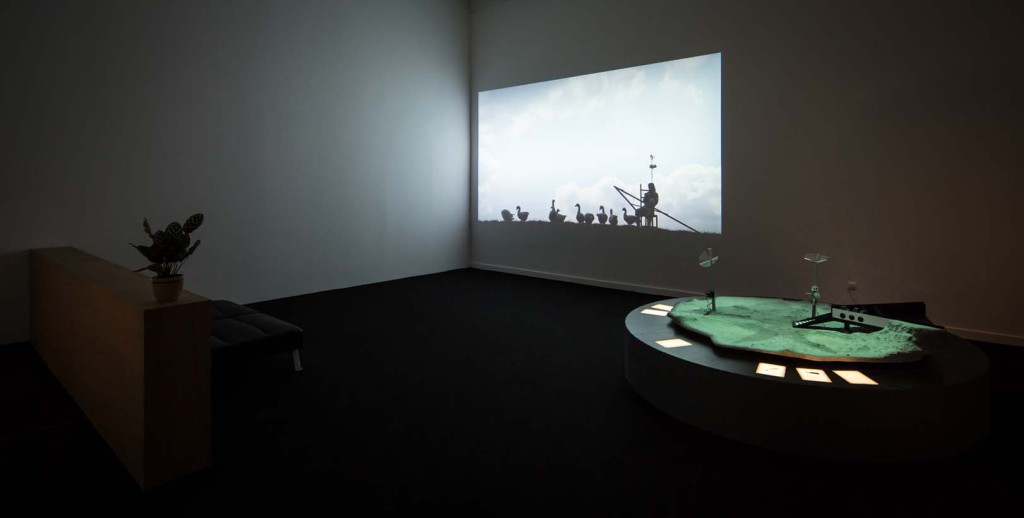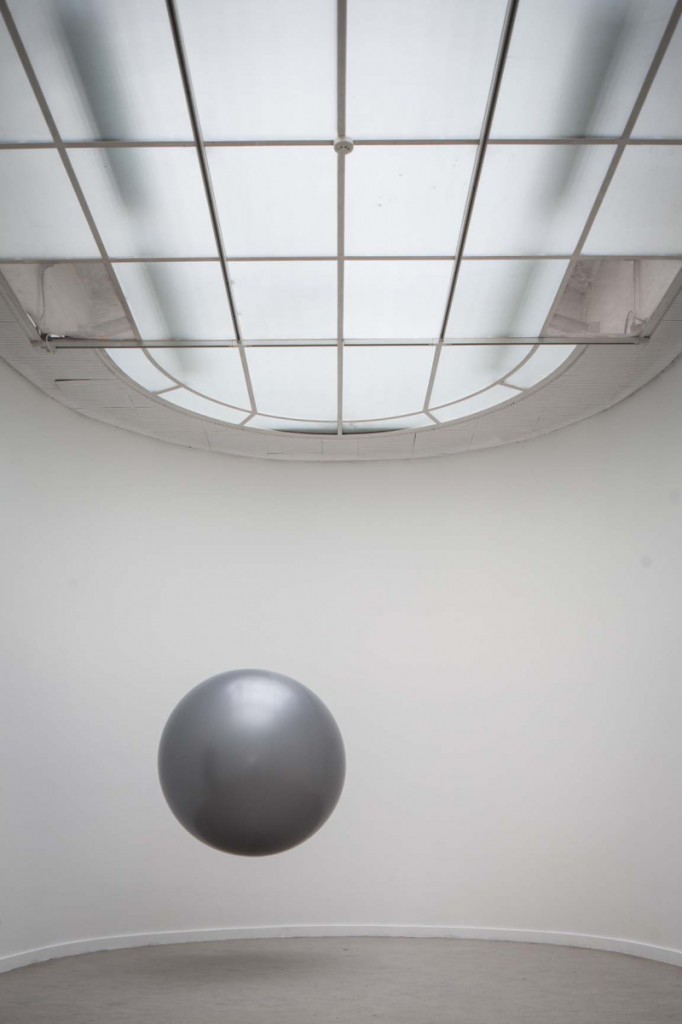The New Space Race. Artists and Space Research
Artists increasingly take space in their own hands, create visions and prototypes, and collaborate with scientists and space organizations such as NASA or ESA. Obviously art plays a different game than science or technology, but the artist’s view on space travel invites us to look at the broader social, cultural and philosophical implications.

Outer space continues to be an endless source of fascination and inspiration for artists, writers and filmmakers. The dream to be able to leave the earth or the desire to explore new worlds gives man a freedom to fantasize about alternate realities and future scenarios.
Increasing internationalization, privatization and democratization has created new possibilities for space travel, pushing it towards new directions. Consequently, space travel has taken off again, as evidenced by artists’ renewed enthusiasm. Growing amounts of available knowledge and new technologies are appropriated into the artist’s practice. They perform their own scientific experiments, build open source satellites or try to launch their homemade rockets. At the same time, there is a growing interest from the scientific community to set up collaborations with artists.
The artist’s positions in these scenarios vary from naïve dreamer, pseudo-scientist, and tinkerer to full member of a research team, but they all offer new perspectives. With their open questions, critical reflections, speculative proposals or alternative actions they go beyond purely scientific, economic or military approaches to space exploration.
Space Odyssey 2.0 presents new stories and creative interdisciplinary DIY practices on the intersection of science and imagination. With the exhibition, Z33 explores a relevant social topic on the intersection between contemporary art and science.
The new space race
Z33 presents Space Odyssey 2.0 against a background of a number of important developments in space travel that have given rise to a new space race.
In recent decades, space travel has come to be organized on an increasingly international level. Today, the space race is no longer dominated by the U.S. and Russia alone; countries like China, India, Japan, Israel and Argentina have set up their own space programmes as well. And the ISS, the International Space Station, has turned international cooperation into a fact. In addition, these days, global communication networks are entirely dependent on satellites. The struggle for independent communication networks is partly fought out in space, where new geopolitical relations are being shaped.
An even more important development, however, is the increasing privatization of the space industry. Many financially strong and dynamic companies are getting involved in the development of new technologies; hence, the developmental pace is no longer set by the government, but rather by the private sector.
And the pace is fast. Just in 2012 alone, there were a number of fundamental breakthroughs in aerospace development. Take, for instance, the first private cargo transport to the ISS, and the development of Stratolaunch, the largest and most powerful aircraft for launching spacecraft ever designed. The first commercial space station is planned for 2015. Even space tourism has become big business and is steadily growing into a new form of luxury entertainment. Both Virgin Galactic and XCOR offer sub-orbital flights, but there are also plans for moon flights, the development of lunar bases, space hotels, flights to Mars and even journeys to other galaxies. The economic drives behind the current space race are telecommunications, space transportation, space tourism and the mining of raw materials.
![Angelo Vermeulen, Seeker [HS2], 2013. © Kristof Vrancken / Z33.](https://z33.be/wp-content/uploads/2016/07/spaceodyssey20-angelovermeulen-seeker12b-1024x455.jpg)
DIY and space 2.0
These developments also prove to be an impetus for a renewed interest in space travel on a smaller scale. As technology and knowledge become increasingly more available in today’s global information network, amateurs, students and artists get involved in the space race through a variety of creative DIY projects. Take, for example, the open source satellite TubeSat, a DIY kit with which one can build a small satellite. Then there is the OSSI (Open Source Satellite Initiative) project set up by artist Hojun Song, that aims to launch its own satellite in 2013 with funds gathered through crowdfunding. The collective Copenhagen Suborbitals is well on its way to develop the first successful DIY manned spacecraft for sub-orbital flights. And finally, there are a host of simple and low-cost experiments on the Internet, such as the filming of the extreme limits of Earth’s atmosphere with a camera-mounted balloon (e.g. Simon Faithfull – Escape Vehicle No. 6 or Stratohab), among many others.
It is clear that people are increasingly and literally taking space into their own hands and seek to actively shape the future. A future in which open collaboration, exchange of information and low-cost and DIY initiatives can stimulate an alternative way of thinking.

Old dreams, new stories
Despite their different interests in space travel, private companies, scientists and amateur hobbyists have one main thing in common: space as the ultimate fantasy and dream. But also artists, authors and filmmakers have found inspiration in that fantasy; think of all the science fiction-inspired art, literature and films. The new space race has become a great source of inspiration for an enthusiastic generation of artists who bring us new stories – and this is precisely the subject of Space Odyssey 2.0.
Fiction is the perfect vehicle by which these new stories explore the philosophical and cultural implications of space science and space travel. Narration, re-enactment and performance intersect with scientific theory and experimentation. A variety of forms of exchange and cooperation are becoming apparent, ranging from artists who use space science to introduce new possible scenarios (Michael Burton), to artists who undertake pseudo-scientific experiments (Panamarenko, Agnes Meyer-Brandis, Andy Gracie). Others set out to transform scientific phenomena into an artistic creation or performance (Frederik De Wilde, Edith Dekyndt, Semiconductor) or manage to turn the scientist into a performer (Nelly Ben Hayoun). Interdisciplinary collaboration, co-creation, experimental practice and imagination are the key elements in these new creative fantasies.
Science meets fiction
New crossovers between art, science and technology are taking place, in all possible directions. Similarly, increasing openness in the field of space research makes collaborations with artists and designers possible. They are, for example, invited to think about the interior design of spacecrafts or find solutions to sensory deprivation during long space voyages. Yet art can equally influence science. National Aeronautics and Space Administration NASA, for instance, is interested in the knowhow artist Frederik De Wilde developed through his artistic research on the so-called nano-black. The darkest material known to man absorbs almost all light and could be further developed to improve the NASA space telescopes. Angelo Vermeulen (artist and PhD in biology), in turn, has been included in a European Space Agency ESA research team because of his mixed background. During the time his DIY spaceship and co-creation project Seeker will be exhibited in Z33, he will participate in a Mars simulation mission that intends to research the issue of food in space.
Space Odyssey 2.0 puts the current space race in a broader perspective. Obviously art plays a different game than science or technology, but the artist’s view on space travel invites us to look at the broader social, cultural and philosophical implications. The new creative practices presented in Space Odyssey 2.0 not only encourage us to think about the future of the human race or the planet, but show us, through their passion for experimentation and creation, a way to fashion our own future.
The article was originally published in the exhibition catalogue of ‘Space Odyssey 2.0’ in February 2013.